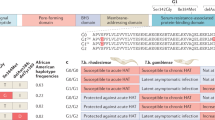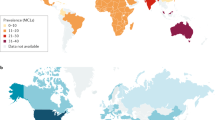Abstract
African Americans have a heightened risk of developing chronic and end-stage kidney disease, an association that is largely attributed to two common genetic variants, termed G1 and G2, in the APOL1 gene. Direct evidence demonstrating that these APOL1 risk alleles are pathogenic is still lacking because the APOL1 gene is present in only some primates and humans; thus it has been challenging to demonstrate experimental proof of causality of these risk alleles for renal disease. Here we generated mice with podocyte-specific inducible expression of the APOL1 reference allele (termed G0) or each of the risk-conferring alleles (G1 or G2). We show that mice with podocyte-specific expression of either APOL1 risk allele, but not of the G0 allele, develop functional (albuminuria and azotemia), structural (foot-process effacement and glomerulosclerosis) and molecular (gene-expression) changes that closely resemble human kidney disease. Disease development was cell-type specific and likely reversible, and the severity correlated with the level of expression of the risk allele. We further found that expression of the risk-variant APOL1 alleles interferes with endosomal trafficking and blocks autophagic flux, which ultimately leads to inflammatory-mediated podocyte death and glomerular scarring. In summary, this is the first demonstration that the expression of APOL1 risk alleles is causal for altered podocyte function and glomerular disease in vivo.
This is a preview of subscription content, access via your institution
Access options
Access Nature and 54 other Nature Portfolio journals
Get Nature+, our best-value online-access subscription
$29.99 / 30 days
cancel any time
Subscribe to this journal
Receive 12 print issues and online access
$209.00 per year
only $17.42 per issue
Buy this article
- Purchase on Springer Link
- Instant access to full article PDF
Prices may be subject to local taxes which are calculated during checkout






Similar content being viewed by others
Accession codes
References
USRDS. US Renal. Data Syst. (2015).
Lipworth, L. et al. Incidence and predictors of end stage renal disease among low-income blacks and whites. PLoS One 7, e48407 (2012).
Tzur, S. et al. Missense mutations in the APOL1 gene are highly associated with end stage kidney disease risk previously attributed to the MYH9 gene. Hum. Genet. 128, 345–350 (2010).
Genovese, G. et al. Association of trypanolytic ApoL1 variants with kidney disease in African Americans. Science 329, 841–845 (2010).
Freedman, B.I. et al. Differential effects of MYH9 and APOL1 risk variants on FRMD3 Association with Diabetic ESRD in African Americans. PLoS Genet. 7, e1002150 (2011).
Foster, M.C. et al. APOL1 variants associate with increased risk of CKD among African Americans. J. Am. Soc. Nephrol. 24, 1484–1491 (2013).
Friedman, D.J. & Pollak, M.R. Genetics of kidney failure and the evolving story of APOL1. J. Clin. Invest. 121, 3367–3374 (2011).
Thomson, R. et al. Evolution of the primate trypanolytic factor APOL1. Proc. Natl. Acad. Sci. USA 111, E2130–E2139 (2014).
Lecordier, L. et al. Adaptation of Trypanosoma rhodesiense to hypohaptoglobinaemic serum requires transcription of the APOL1 resistance gene in a RNA polymerase I locus. Mol. Microbiol. 97, 397–407 (2015).
Bruggeman, L.A. et al. APOL1-G0 or APOL1-G2 transgenic models develop preeclampsia but not kidney disease. J. Am. Soc. Nephrol. 27, 3600–3610 (2016).
Madhavan, S.M. et al. APOL1 localization in normal kidney and nondiabetic kidney disease. J. Am. Soc. Nephrol. 22, 2119–2128 (2011).
Yu, H. et al. A role for genetic susceptibility in sporadic focal segmental glomerulosclerosis. J. Clin. Invest. 126, 1067–1078 (2016).
Larsen, C.P. et al. Histopathologic findings associated with APOL1 risk variants in chronic kidney disease. Mod. Pathol. 28, 95–102 (2015).
Kopp, J.B. et al. Clinical features and histology of apolipoprotein L1-associated nephropathy in the FSGS clinical trial. J. Am. Soc. Nephrol. 26, 1443–1448 (2015).
Ng, D.K. et al. APOL1-associated glomerular disease among African-American children: a collaboration of the Chronic Kidney Disease in Children (CKiD) and Nephrotic Syndrome Study Network (NEPTUNE) cohorts. Nephrol. Dial. Transplant. http://dx.doi.org/10.1093/ndt/gfw061 (2016).
Jotwani, V. et al. APOL1 genotype and glomerular and tubular kidney injury in women with HIV. Am. J. Kidney Dis. 65, 889–898 (2015).
Parsa, A. et al. APOL1 risk variants, race, and progression of chronic kidney disease. N. Engl. J. Med. 369, 2183–2196 (2013).
Tin, A. et al. Patterns of kidney function decline associated with APOL1 genotypes: results from AASK. Clin. J. Am. Soc. Nephrol. 11, 1353–1359 (2016).
Ledo, N. et al. Functional genomic annotation of genetic risk loci highlights inflammation and epithelial biology networks in CKD. J. Am. Soc. Nephrol. 26, 692–714 (2015).
Sampson, M.G. et al. Integrative genomics identifies novel associations with APOL1 risk genotypes in black NEPTUNE subjects. J. Am. Soc. Nephrol. 27, 814–823 (2016).
Zhaorigetu, S., Wan, G., Kaini, R., Jiang, Z. & Hu, C.A. ApoL1, a BH3-only lipid-binding protein, induces autophagic cell death. Autophagy 4, 1079–1082 (2008).
Furuta, N. & Amano, A. SNARE mediates autophagosome–lysosome fusion. Journal of Oral Biosciences 54, 83–85 (2012).
Müller-Deile, J. & Schiffer, M. Podocyte directed therapy of nephrotic syndrome-can we bring the inside out? Pediatr. Nephrol. 31, 393–405 (2016).
Tao, J., Polumbo, C., Reidy, K., Sweetwyne, M. & Susztak, K. A multicolor podocyte reporter highlights heterogeneous podocyte changes in focal segmental glomerulosclerosis. Kidney Int. 85, 972–980 (2014).
Byrne, B.G., Dubuisson, J.F., Joshi, A.D., Persson, J.J. & Swanson, M.S. Inflammasome components coordinate autophagy and pyroptosis as macrophage responses to infection. MBio 4, e00620–e12 (2013).
Shahzad, K. et al. Caspase-1, but not caspase-3, promotes diabetic nephropathy. J. Am. Soc. Nephrol. 27, 2270–2275 (2016).
Inoki, K. mTOR signaling in autophagy regulation in the kidney. Semin. Nephrol. 34, 2–8 (2014).
Nichols, B. et al. Innate immunity pathways regulate the nephropathy gene Apolipoprotein L1. Kidney Int. 87, 332–342 (2015).
Kasembeli, A.N. et al. APOL1 risk variants are strongly associated with HIV-associated nephropathy in Black South Africans. J. Am. Soc. Nephrol. 26, 2882–2890 (2015).
Thomson, R. & Finkelstein, A. Human trypanolytic factor APOL1 forms pH-gated cation-selective channels in planar lipid bilayers: relevance to trypanosome lysis. Proc. Natl. Acad. Sci. USA 112, 2894–2899 (2015).
Wan, G. et al. Apolipoprotein L1, a novel Bcl-2 homology domain 3-only lipid-binding protein, induces autophagic cell death. J. Biol. Chem. 283, 21540–21549 (2008).
Cheng, D. et al. Biogenesis and cytotoxicity of APOL1 renal risk variant proteins in hepatocytes and hepatoma cells. J. Lipid Res. 56, 1583–1593 (2015).
Galindo-Moreno, J. et al. Apolipoprotein L2 contains a BH3-like domain but it does not behave as a BH3-only protein. Cell Death Dis. 5, e1275 (2014).
Heneghan, J.F. et al. BH3 domain-independent apolipoprotein L1 toxicity rescued by BCL2 prosurvival proteins. Am. J. Physiol. Cell Physiol. 309, C332–C347 (2015).
Hartleben, B. et al. Autophagy influences glomerular disease susceptibility and maintains podocyte homeostasis in aging mice. J. Clin. Invest. 120, 1084–1096 (2010).
Hartleben, B., Wanner, N. & Huber, T.B. Autophagy in glomerular health and disease. Semin. Nephrol. 34, 42–52 (2014).
Kawakami, T. et al. Deficient autophagy results in mitochondrial dysfunction and FSGS. J. Am. Soc. Nephrol. 26, 1040–1052 (2015).
Tagawa, A. et al. Impaired podocyte autophagy exacerbates proteinuria in diabetic nephropathy. Diabetes 65, 755–767 (2016).
Yamamoto-Nonaka, K. et al. Cathepsin D in podocytes is important in the pathogenesis of proteinuria and CKD. J. Am. Soc. Nephrol. 27, 2685–2700 (2016).
Gabay, C., Lamacchia, C. & Palmer, G. IL-1 pathways in inflammation and human diseases. Nat. Rev. Rheumatol. 6, 232–241 (2010).
Turner, C.M., Arulkumaran, N., Singer, M., Unwin, R.J. & Tam, F.W. Is the inflammasome a potential therapeutic target in renal disease? BMC Nephrol. 15, 21 (2014).
Li, P. et al. Mice deficient in IL-1 beta-converting enzyme are defective in production of mature IL-1 beta and resistant to endotoxic shock. Cell 80, 401–411 (1995).
Doitsh, G. et al. Cell death by pyroptosis drives CD4 T-cell depletion in HIV-1 infection. Nature 505, 509–514 (2014).
Haque, S. et al. HIV promotes NLRP3 inflammasome complex activation in murine HIV-associated nephropathy. Am. J. Pathol. 186, 347–358 (2016).
Lin, X., Suh, J.H., Go, G. & Miner, J.H. Feasibility of repairing glomerular basement membrane defects in Alport syndrome. J. Am. Soc. Nephrol. 25, 687–692 (2014).
Klionsky, D.J. et al. Guidelines for the use and interpretation of assays for monitoring autophagy (3rd edition). Autophagy 12, 1–222 (2016).
Sakairi, T. et al. Conditionally immortalized human podocyte cell lines established from urine. Am. J. Physiol. Renal Physiol. 298, F557–F567 (2010).
Soda, K. et al. Role of dynamin, synaptojanin, and endophilin in podocyte foot processes. J. Clin. Invest. 122, 4401–4411 (2012).
Acknowledgements
Work performed in the Susztak lab is supported by US National Institutes of Health (NIH) grants DK105821, DK087635, DK076077 and DP3 DK108220. The human kidney RNA-sequencing project was performed in collaboration with Boehringer Ingelheim. J. Bi-Karchin was supported by 2T32DK007006. J.B. Kopp. and P.D.D. were supported by the Intramural Research Program, NIDDK, NIH. J.H.M. was supported by R01DK078314 and R01DK058366; T.R. by GM093290 and NS055159; and A.M.C. by AG054108 (NIH). M.A.S. was supported by Kids Kidney Research, and the Bristol Nutrition NIHR-BRU. We would also like to thank the Electron Microscopy Resource Laboratory (EMRL) core facility at the University of Pennsylvania for technical support.
Author information
Authors and Affiliations
Contributions
P.B. and J.B.-K. designed and performed the experiments, and wrote and revised the manuscript. A.S.D.P. performed initial animal characterization and in vitro studies (TEM and IF). C.Q. analyzed RNA-sequencing data. P.D.D. and J.B.K. helped with the discussion and generated mCherry-APOL1-G0/G1/G2 stable cell lines (not used in the paper). I.S. generated TRE-GFP/APOL1-G1 stable HEK293 cell line. C.M.B.-K. and S.S.P. contributed to the human data presented in the paper. J.H.M. provided the Nphs1-transgenic mice. C.-A.A.H. provided the original APOL1 constructs. T.R. made the bicistronic plasmids containing TRE-GFP/APOL1-G0/G1/G2. K.I. and S.I. provided help with spinning disk confocal microscopy. M.A.S. provided human podocytes. M.B.P. performed the pathological characterization. A.M.C. helped with autophagy studies. K.S. designed and supervised the study and wrote and revised the manuscript.
Corresponding author
Ethics declarations
Competing interests
The Susztak lab is supported in part by Boehringer Ingelheim for a study related to the human data presented in the paper.
Supplementary information
Supplementary Figures and Tables
Supplementary Figures 1–9 and Supplementary Tables 1–4 (PDF 11328 kb)
41591_2017_BFnm4287_MOESM2_ESM.avi
APOL1 is colocalized to the late endosome. Spinning disc confocal microscopy movie of GFP-APOL1(green) and RFPRab7 (late endosome, red). Scale bar: 5μm. (AVI 3516 kb)
41591_2017_BFnm4287_MOESM3_ESM.avi
Risk allele APOL1 shows increased accumulation of recycling endosome. Spinning disc confocal microscopy movies of GFP-APOL1-G0 (AVI 3516 kb)
41591_2017_BFnm4287_MOESM4_ESM.avi
Risk allele APOL1 shows increased accumulation of recycling endosome. Spinning disc confocal microscopy movies of GFP-APOL1-G2 (green) and RFPRab11 (recycling endosome, red), Scale bar: 5μm. (AVI 3341 kb)
Rights and permissions
About this article
Cite this article
Beckerman, P., Bi-Karchin, J., Park, A. et al. Transgenic expression of human APOL1 risk variants in podocytes induces kidney disease in mice. Nat Med 23, 429–438 (2017). https://doi.org/10.1038/nm.4287
Received:
Accepted:
Published:
Issue Date:
DOI: https://doi.org/10.1038/nm.4287
This article is cited by
-
HIF-2α/LINC02609/APOL1-mediated lipid storage promotes endoplasmic reticulum homeostasis and regulates tumor progression in clear-cell renal cell carcinoma
Journal of Experimental & Clinical Cancer Research (2024)
-
The changing landscape of HIV-associated kidney disease
Nature Reviews Nephrology (2024)
-
Apolipoprotein L1 (APOL1) renal risk variant-mediated podocyte cytotoxicity depends on African haplotype and surface expression
Scientific Reports (2024)
-
Inaxaplin als potenzielle Therapie der APOL1-assoziierten Nephropathie
Die Nephrologie (2024)
-
The Janus-faced functions of Apolipoproteins L in membrane dynamics
Cellular and Molecular Life Sciences (2024)



